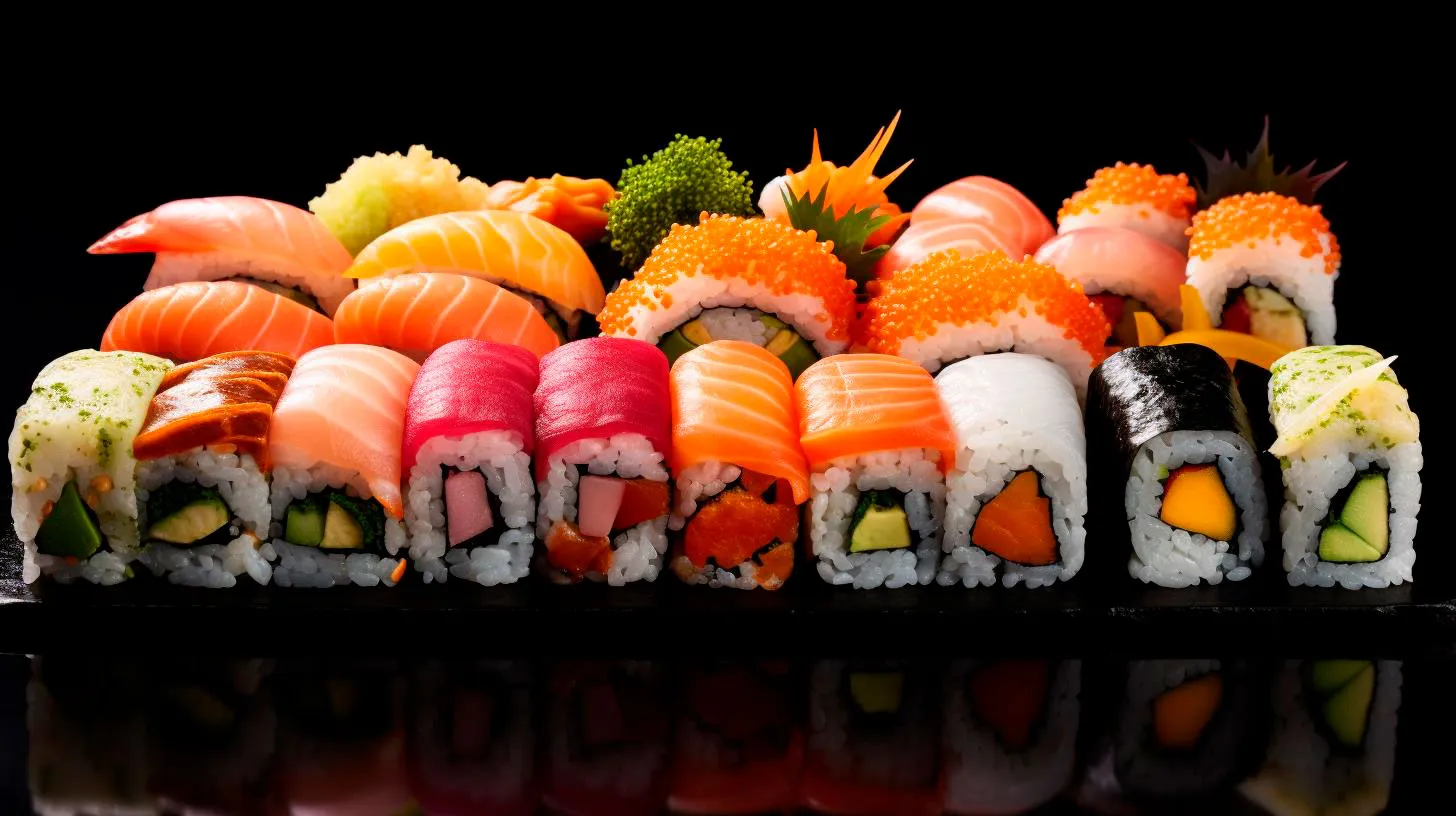From Ancient Origins to Modern Delicacy: Sushi Artifacts Revealed
In this article, we will take a deep dive into the historical roots of sushi, explore its transformation over the centuries, and discover the secrets behind its enduring popularity.
The Origins: Rice Preservation Techniques
The story of sushi begins in ancient Southeast Asia, where the preservation of fish using fermented rice was a common practice. This technique involved wrapping the fish in rice to create a natural fermentation process. Over time, this method spread to China and later reached Japan during the 9th century.
Key Takeaways:
- Sushi originated from Southeast Asia and later reached Japan during the 9th century.
- An ancient preservation technique involved fermenting fish with rice.
The Birth of Nigiri and Maki Rolls
During the Muromachi period in Japan (14th-16th century), sushi started to evolve further. Chefs began preparing vinegared rice as a way to prevent spoilage, a technique known as “Nare-zushi.” Rice was mixed with fermented rice vinegar, salt, and other ingredients to enhance the flavor and preserve the fish. This marked the birth of nigiri sushi, where a slice of fish was placed on top of a small mound of vinegared rice, allowing the flavors to meld together.
Another significant development during this period was the invention of the maki roll. Chefs discovered that wrapping the fish and rice in seaweed not only enhanced the taste but also made it easier to consume. Maki rolls quickly gained popularity due to their convenience and portability.
Key Takeaways:
- Vinegared rice was introduced in the Muromachi period to prevent spoilage and enhanced flavor.
- The birth of nigiri sushi involved placing a slice of fish on vinegared rice.
- Maki rolls were invented by wrapping the fish and rice in seaweed.
The Era of Sushi Chefs and Edo Sushi
In the early 19th century, sushi underwent a significant transformation during the Edo period in Japan. This era saw the emergence of sushi as a street food, served in small stalls and food carts. Dedicated sushi chefs known as itamae honed their skills and developed unique techniques to create the highest quality sushi.
Edo-style sushi, also known as nigiri-zushi, became synonymous with precision and craftsmanship. Chefs focused on using the freshest ingredients and meticulously crafted each piece by hand. The incorporation of various seafood, such as tuna, yellowtail, and sea urchin, allowed for a diverse and flavorful sushi experience.
Key Takeaways:
- The Edo period marked the rise of sushi as a street food.
- Dedicated sushi chefs, known as itamae, honed their skills to create the highest quality sushi.
- Edo-style sushi prioritized the use of fresh ingredients and meticulous handcrafting.
Sushi Goes Global: Popularity and Cultural Influence
Sushi gained international recognition after World War II, thanks to the introduction of refrigeration and improved transportation systems. The simplicity and elegance of sushi appealed to people around the world, and its popularity soared. Today, sushi has become a symbol of Japanese culture and an essential part of the global culinary landscape.
Key Takeaways:
- Sushi gained global popularity after World War II.
- Sushi has become a symbol of Japanese culture and an integral part of the global culinary landscape.
The Benefits of Sushi: A Healthful and Nutritious Choice
Aside from its rich history and cultural significance, sushi offers numerous health benefits. The use of fresh fish provides an excellent source of high-quality protein, omega-3 fatty acids, and essential vitamins. Additionally, the minimal use of oil and high vegetable content in sushi make it a low-calorie option.
Key Takeaways:
- Sushi is a good source of high-quality protein, omega-3 fatty acids, and essential vitamins.
- Sushi is a low-calorie option due to its minimal use of oil and high vegetable content.
Conclusion
From its humble beginnings as a preservation technique to its status as a beloved culinary masterpiece, sushi has come a long way. The art of sushi-making has transcended time and borders, captivating the hearts and palates of food enthusiasts worldwide. Understanding the ancient origins and evolution of sushi allows us to appreciate the craftsmanship and innovation behind this iconic dish.
So the next time you indulge in a plate of beautifully crafted sushi, take a moment to reflect on its journey through history and savor the perfect blend of tradition, skill, and taste.
Tracing Sushi History: A Dive into Historical Artifacts
Delving into the past, we find not only a delectable delight but also a fascinating story filled with tradition and innovation.
The Origins of Sushi
Sushi, in its earliest form, dates back to the 7th century in Southeast Asia. Known as narezushi, this ancient version of sushi involved fermenting fish with rice, allowing it to mature and develop a distinctive flavor. The fermented rice served as a preservation method for the fish, enabling it to be stored for extended periods.
Over time, sushi began to evolve as it migrated to different parts of Japan. In the 17th century, a breakthrough occurred with the introduction of sushi as we know it today. This style, known as Edomae sushi, originated in Edo (now Tokyo), where street stalls started serving nigiri sushi, a hand-pressed form of sushi where a small pat of rice is topped with a slice of raw fish.
A Glimpse into Sushi’s Historical Artifacts
The rich history of sushi is not only written in words but is also beautifully preserved through historical artifacts. Let’s dive into a few key artifacts that give us a glimpse into sushi’s past:
1. Makisu (Bamboo Sushi Mat)
The makisu, a bamboo sushi mat, is an indispensable tool in the sushi-making process. Crafted from bamboo slats woven together with cotton string, this ancient tool has been used for centuries to roll sushi. Its design allows sushi chefs to create perfectly shaped rolls, ensuring a consistent size and texture.
Key Takeaway: The makisu plays a crucial role in maintaining the renowned aesthetic appeal of sushi rolls.
2. Hangiri (Wooden Sushi Rice Tub)
The hangiri, a large wooden tub, is used to mix and cool sushi rice. Traditionally made from cypress wood, the hangiri absorbs excess moisture from the rice, ensuring the perfect texture for sushi. The unique wooden material also imparts a subtle aroma and flavor to the rice, further enhancing the overall sushi experience.
Key Takeaway: The hangiri is an essential tool for achieving the ideal sushi rice texture.
3. Yanagiba (Sushi Knife)
A yanagiba, a long and slender sushi knife, is instrumental in creating those precise, clean cuts that sushi is famous for. With a single-edged blade crafted from high-quality carbon steel, this knife allows chefs to slice through fish with minimal effort, ensuring the integrity and presentation of each piece of sushi.
Key Takeaway: The yanagiba is the go-to knife for sushi chefs, enabling them to achieve the perfect slices of fresh fish.
Advancements in Sushi
While sushi has deep historical roots, it has also experienced various advancements that have propelled it into the culinary world we know today. Here are a few notable advancements:
1. Refrigeration and Transportation
In the early 20th century, the introduction of refrigeration and faster transportation methods allowed sushi to be enjoyed beyond the coastal areas of Japan. This breakthrough enabled sushi to reach a wider audience, leading to its global popularity.
Key Takeaway: Refrigeration and improved transportation have played a crucial role in the globalization of sushi.
2. Sushi Conveyor Belts
In the 1950s, sushi chef Yoshiaki Shiraishi revolutionized the sushi dining experience by introducing the conveyor belt system. This automated method allowed diners to select their desired sushi dishes as they passed by on a conveyor belt, making sushi more accessible and enhancing the dining experience.
Key Takeaway: The introduction of conveyor belt sushi brought a new level of convenience and interaction to traditional sushi restaurants.
The Takeaway
Sushi, with its intriguing history and cultural significance, continues to captivate people around the world. Through the exploration of historical artifacts and the advancements that have shaped this beloved cuisine, we gain a deeper appreciation for the artistry and craftsmanship behind each sushi roll.
So, the next time you enjoy a plate of exquisitely prepared sushi, take a moment to savor not only the flavors but also the centuries of tradition and innovation that have brought this extraordinary dish to your table.
Sushi-inspired Art: A Journey Through Time
The Rise of Sushi Art
In recent years, the popularity of sushi has skyrocketed, not only as a delicious cuisine but also as an art form. Sushi chefs have transformed the simple act of creating this traditional Japanese delicacy into a mesmerizing performance, captivating diners around the globe. This visual appeal has inspired many artists to explore sushi as a theme in their work.
- Visual Aesthetics: The colorful combination of fresh fish, vibrant vegetables, and carefully molded rice makes sushi an aesthetically pleasing subject for artists.
- Cultural Significance: Sushi represents Japanese culture and craftsmanship, making it an intriguing subject for artists looking to convey a sense of tradition and heritage.
- Delicacy and Precision: The delicate nature of sushi preparation requires precision and attention to detail, qualities that resonate with artists seeking to portray meticulousness in their work.
Famous Sushi-inspired Artworks
1. “Sushi” by Takashi Murakami

Takashi Murakami, a renowned Japanese contemporary artist, is famous for his vibrant and playful artwork. In his piece titled “Sushi,” Murakami combines his distinctive anime-style characters with sushi motifs, creating a visually striking work that effortlessly blends traditional and contemporary elements.
2. “The Great Wave off Kanagawa” by Katsushika Hokusai

Although not solely focused on sushi, Katsushika Hokusai’s iconic woodblock print “The Great Wave off Kanagawa” prominently features the fishing culture of Japan. This masterpiece captures the sheer power of nature and its connection to the lives of fishermen who ultimately contribute to the creation of sushi.
3. Sushi Sculptures by Tama-chan

Tama-chan, a talented artist known for her intricate food sculptures, has gained recognition for her sushi-inspired creations. Using polymer clay and other materials, she meticulously sculpts miniature sushi pieces that look incredibly realistic. Her attention to detail not only showcases the artistry of sushi but also prompts viewers to question the line between food and art.
The Intersection of Culinary Delight and Visual Splendor
Sushi-inspired art is more than just a visual representation; it captures the essence of Japanese cuisine, traditions, and the cultural exchange that sushi symbolizes. These artworks provide a unique perspective on the intersection of culinary delight and visual splendor, inviting viewers to appreciate the artistry behind the creation of this beloved cuisine.
- Cultural Appreciation: Sushi artwork serves as a bridge to Japanese culture, allowing viewers to gain a deeper understanding and appreciation for the traditions associated with this culinary art form.
- Food as Art: By showcasing sushi as a subject, artists challenge the boundaries of what is traditionally considered art, blurring the line between food and artistic creation.
- Inspiration for Creatives: Sushi-inspired art provides a well of inspiration for artists, encouraging them to explore new themes and experiment with diverse materials in their own work.
Conclusion
Sushi has transcended its culinary origins to become a source of inspiration for artists worldwide. From masterpieces that depict sushi motifs to sculptures that mimic the delicacy of handmade rolls, sushi-inspired art offers a unique perspective on the intersection of food and creativity.
As sushi continues to captivate the taste buds of people across the globe, its influence on the world of art remains ever-present. Through mesmerizing visuals and a deep appreciation for Japanese culture, these artworks invite viewers to embark on a journey through time, exploring the beauty and intricacy of sushi-inspired art.
Unearthing the Past: Sushi-themed Historical Artifacts
In this blog post, we embark on a journey to unearth sushi-themed historical artifacts that offer a glimpse into the past and deepen our appreciation for this beloved cuisine.
1. Sushi Presses and Molds
One of the most iconic sushi artifacts is the sushi press or mold. These pieces were used to shape rice and toppings into perfectly formed sushi rolls. Dating back to the Edo period in Japan (1603–1868), these molds were intricately carved out of wood, often featuring intricate designs and patterns. The molds were not only functional but also considered works of art.
Key Takeaway: Sushi molds from the Edo period highlight the importance of presentation and aesthetics in sushi preparation.
2. Noren Curtains
Noren curtains are traditional Japanese fabric dividers used to separate spaces or mark the entrance to shops and restaurants. These curtains often feature beautiful illustrations related to the establishment’s theme, including sushi. Sushi-themed noren curtains not only added a decorative touch but also indicated the presence of a sushi establishment, inviting passersby to step into a world of culinary delight.
Key Takeaway: Sushi-themed noren curtains served as an enticing invitation to experience the flavors and ambiance of a sushi restaurant.
3. Sushi Knives
The art of sushi-making extends beyond the delicate balance of flavors. It also demands precision and expertise when it comes to cutting the ingredients. Sushi knives, known as “hocho,” are another interesting artifact associated with this cuisine. These knives are crafted with utmost care and often feature unique designs, such as the traditional single-edged blade known as “yanagiba” or the more versatile “usuba.” Through the craftsmanship of these knives, sushi chefs can achieve the perfect cut, enhancing the overall dining experience.
Key Takeaway: Sushi knives are essential tools for sushi chefs, enabling them to master the art of precise ingredient preparation.
4. Sushi-Eating Utensils
No exploration of sushi artifacts would be complete without mentioning the traditional utensils used to enjoy this beloved cuisine. Two key utensils are the “hashi” (chopsticks) and the “oyu-gashi” (lacquered wooden tray). Chopsticks embody the essence of Asian dining, offering an elegant and efficient way to savor sushi delicacies. On the other hand, the oyu-gashi not only serves as a tray but also acts as a symbol of sophistication, adding elegance to the overall dining experience.
Key Takeaway: The proper use of sushi-eating utensils enhances not only the practical aspect but also the cultural appreciation of this culinary art form.
5. Sushi-themed Artwork and Prints
Throughout history, sushi has captivated artists who have boldly expressed their love for this dish through various art forms. Sushi-themed artwork and prints, such as woodblock prints or ukiyo-e, were especially popular during the Edo period. These works not only showcased the beauty of sushi but also reflected the social and cultural aspects of that era. Today, these artifacts continue to inspire artists and enthusiasts, keeping the sushi legacy alive through visual representation.
Key Takeaway: Sushi-themed artwork provides a visual narrative of sushi’s historical and cultural significance.
In Conclusion
Unearthing sushi-themed historical artifacts offers us a unique window into the past, revealing the evolution of this beloved cuisine and its deep-rooted cultural significance. From sushi presses and molds to noren curtains, sushi knives to eating utensils, and artwork to prints, each artifact tells its own story, showcasing the artistry, precision, and cultural heritage that make sushi so much more than just a delightful gastronomic experience.
So the next time you indulge in a piece of sushi, remember the centuries-old legacy behind it, and savor every bite with a newfound appreciation.



